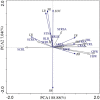Evaluation of growth adaptation of Cinnamomum camphora seedlings in ionic rare earth tailings environment
- PMID: 37805611
- PMCID: PMC10560214
- DOI: 10.1038/s41598-023-44145-z
Evaluation of growth adaptation of Cinnamomum camphora seedlings in ionic rare earth tailings environment
Abstract
The root system is an important organ for nutrient uptake and biomass accumulation in plants, while biomass allocation directly affects essential oils content, which plays an essential role in plant growth and development and resistance to adverse environmental conditions. This study was undertaken to investigate the differences and correlation of biomass allocation, root traits and essential oil content (EOC), as well as the adaptations of camphor tree with different chemical types to the ionic rare earth tailing sand habitats. Data from 1-year old cutting seedlings of C. camphora showed that the biomass of C. camphora cuttings was mainly distributed in root system, with the ratio of root biomass 49.9-72.13% and the ratio of root to canopy 1.00-2.64. The total biomass was significantly positively correlated with root length (RL), root surface area (RSA) and dry weight of fine roots (diameter ≤ 2 mm) (P < 0.05). Root biomass and leaf biomass were negatively and positively with specific root length (SRL) and specific root surface area (SRSA), respectively. Leaf biomass presented a positive effect on EOC (P < 0.05), with the correlation coefficient of 0.808. The suitability sort of these camphor trees was as follows: C. camphora β-linalool, C. camphora α-linaloolII, C. camphora α-linaloolI being better adapted to the ionic rare earth tailings substrate, C. camphora citral being the next, and C. porrectum β-linalool and C. camphora borneol being the least adaptive. EOC played a positive role in the adaptation of C. camphora (R2 = 0.6099, P < 0.05). Therefore camphor tree with linalool type is the appropriate choice in the ecological restoration of ionic rare earth tailings. The study could provide scientific recommendations for the ecological restoration of ionic rare earth tailings area combined with industrial development.
© 2023. Springer Nature Limited.
Conflict of interest statement
The authors declare no competing interests.
Figures



Similar articles
-
Chemical Variation and Environmental Influence on Essential Oil of Cinnamomum camphora.Molecules. 2023 Jan 18;28(3):973. doi: 10.3390/molecules28030973. Molecules. 2023. PMID: 36770639 Free PMC article.
-
Adaptive strategies in architecture and allocation for the asymmetric growth of camphor tree (Cinnamomum camphora L.).Sci Rep. 2024 Sep 30;14(1):22604. doi: 10.1038/s41598-024-72732-1. Sci Rep. 2024. PMID: 39349553 Free PMC article.
-
The Chemical Profiling of Essential Oils from Different Tissues of Cinnamomum camphora L. and Their Antimicrobial Activities.Molecules. 2021 Aug 24;26(17):5132. doi: 10.3390/molecules26175132. Molecules. 2021. PMID: 34500567 Free PMC article.
-
Phytochemistry and Applications of Cinnamomum camphora Essential Oils.Molecules. 2022 Apr 22;27(9):2695. doi: 10.3390/molecules27092695. Molecules. 2022. PMID: 35566046 Free PMC article. Review.
-
[Chemical composition and pharmacological effects of Cinnamomum camphora chvar. borneol essential oil: a review].Zhongguo Zhong Yao Za Zhi. 2024 Jun;49(11):2863-2870. doi: 10.19540/j.cnki.cjcmm.20240227.301. Zhongguo Zhong Yao Za Zhi. 2024. PMID: 39041145 Review. Chinese.
References
-
- Li X, Chen Z, Chen Z, Zhang Y. A human health risk assessment of rare earth elements in soil and vegetables from a mining area in Fujian Province, Southeast China. Chemosphere. 2013;93(6):1240–1246. - PubMed
-
- Zhang H, Lu X, Jin Z, Li Y, Wang R, Li Z, Liu L. Effects of drought on physiological characteristics of seedlings of four species grown on rare earth mill tailings at high temperatures. Acta Ecol. Sin. 2019;39(07):164–172.
-
- Pereira I, Severino P, Santos AC, Silva A, Eliana B. Linalool bioactive properties and potential applicability in drug delivery systems. Colloids Surf. B. 2018;171:566–578. - PubMed
-
- Camargo S, et al. Antihypertensive potential of linalool and linalool complexed with β-yclodextrin, effects of subchronic treatment on blood pressure and vascular reactivity. Biochem. Pharmacol. 2018;151:38–46. - PubMed
-
- Guo L, Huang L, Hua Y, Chen M. From phenotypic plasticity, ecotype to chemotype of medicinal plants. Res. Sci. 2008;30(5):744–750.
Publication types
MeSH terms
Substances
LinkOut - more resources
Full Text Sources
Miscellaneous

